Trucker Access › Forums › Diesel News › All About Truck Tires: Load Ratings, Sizes & More – Equipment
- This topic has 0 replies, 1 voice, and was last updated 11 months ago by
 EazyRiDer66.
EazyRiDer66.
-
AuthorPosts
-
May 23, 2024 at 1:15 pm #21825
 EazyRiDer66Keymaster
EazyRiDer66Keymaster
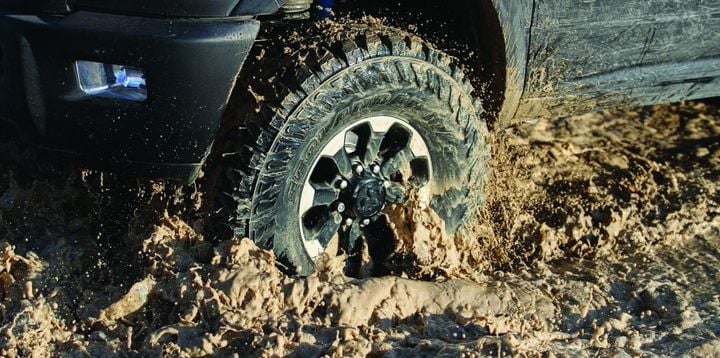
Fleet truck tires have to be able to handle paved roads to dirt roads and everything in between. Having the right tires on your truck and equipment keeps drivers safe and fleets running.
Do you understand truck tires and the impac tthey have on your commercial work truck fleet? Beyond just the basics? Having a complete understanding of everything related to your vehicle’s tires is crucial for today’s fleet managers. And a lot keeps changing. From electric-vehicle needs to last-mile delivery, not every commercial tire is created equal.
When considering tires for your fleet operation, some important items to keep in mind and understand include:
- Tire load ratings.
- Truck tire sizes.
- How tire ply impacts load ratings.
- Differences in truck trailer tires.
- Changes in tires over the years.
Since 2019, Work Truck has been updating and assembling the best truck tire explainer for commercial fleet managers and drivers with the latest information. Check it out!
Fleet 101: Tire Load Ratings
So, what’s the importance of knowing a tire’s load rating? In a nutshell, a load rating directly impacts a vehicle’s carrying capacity. Load ratings influence both passenger and commercial truck tires.
“Tires have different load ratings based on a combination of factors. Load ratings vary by size, construction, application, and inflation pressure,” explained Phillip Mosier, manager of Commercial Tire Development for Cooper Tire & Rubber Company.
How important is a tire load rating? All tires for trucks, big and small, have a recommended load rating.
“A tire’s load rating is specified by one of the various tire industry standardizing organizations around the world. This is true whether the tire is a passenger-type or light-truck-type tire,” said Bob Toth, director of industry relations for Goodyear.
In the U.S., the Tire and Rim Association (TRA) is the standardizing organization for tires. The Association publishes an annual yearbook with load and inflation tables for each tire size. This vital information is also available on the sidewall of the tire.
“The sidewall of a tire shows the maximum load-carrying capacity and the minimum air pressure required to carry this load,” said Helmut Keller, Continental’s head of brand and product management for commercial vehicle tires in the Americas region.
However, one difference between passenger and commercial tires, is that only the minimum air pressure will be shown on a commercial tire, whereas passenger tires also include maximum air pressure.
With industry member assistance, load and inflation standards have been developed over the years, considering the size of the tire’s air containment chamber, inflation pressure, and usage.
“Additionally, load provisions are specified for tires designed with reinforced constructions, typically described as XL (extra load) tires for passenger, or higher load range symbols for LT (light truck),” Toth said.
Printed material may not reflect the latest load and inflation standards, so it is best to refer to online guides or contact tire OEs for help.
“Always refer to the tire sidewall markings for maximum load and pressure information. Never exceed the rim manufacturer’s maximum air pressure limitation. When in doubt, contact the manufacturer’s customer service representative for assistance,” said Paul Tatarchuk, special services coordinator for Michelin North America, Inc.
Most tires for trucks today are rated G or H.
“Based on the size, most G-rated tires can hold approximately 6,000 pounds, while an H-rated in the same size can hold roughly 6,500 pounds at the same pressure per tire,” said Rob Williams, president of Hankook Tire America Corp.
How to Understand Tire Sizes for Light-Duty Trucks
When looking at truck tire sizes, three tire sizes are used on OE tires for light-duty trucks:
- P-Metric
- LT-Metric
- Euro-Metric.
According to Yokohama Tire, light truck tires that adhere to the TRA’s standard typically begin with the letters “LT.” This designation signifies that the tire is a light truck-metric size intended for use on pickup trucks, which have greater cargo carrying and towing capacities compared to passenger cars.
For instance, a common sizing convention for this type of tire is LT235/75R15. Older tires may have the LT designation at the end of the tire size.
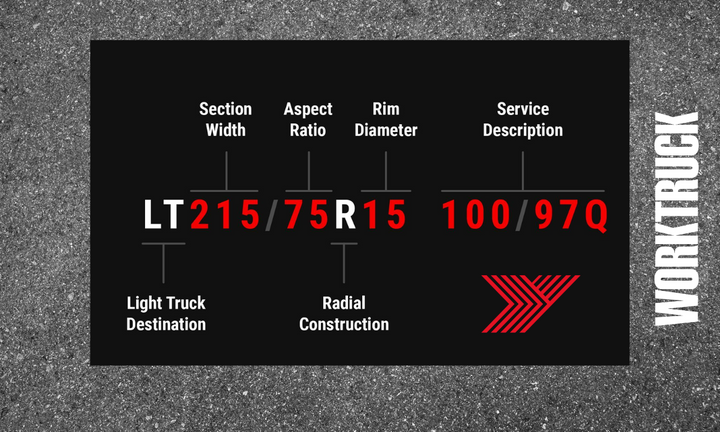
Yokohama noted that light truck tires designed based on the TRA’s standard often start with two letters: LT.
Photo: Yokohama | Work Truck
What truck sizes use what tire type? There are several types of tires for trucks, and it’s important to understand the difference.
According to The Tire Rack:
- Many ¼- and ½-ton trucks use P-Metric and Euro-Metric
- ¾- and 1-ton trucks use LT-Metric sizes.
One common term when talking about tires is load index. But, what does that mean for a truck tire, and how do you read a tire load index chart?
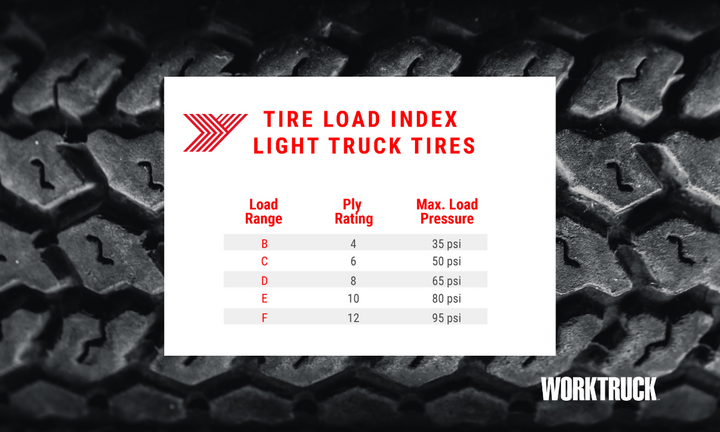
A tire’s maximum load is the most weight the tire is designed to carry.
Photo: Yokohama | Work Truck
“The nominal width of the tire cross-section is measured in millimeters, which is why it’s called P-Metric,” said Tatarchuk of Michelin North America. “Load index is a numerical code that indicates the maximum load that a tire can carry at the speed indicated by its speed index in the conditions of use specified by the manufacturer.”
According to Mosier of Cooper Tire & Rubber Co., in addition to being used on light-duty trucks, P-Metric is a global term and is used around the world. The “P” stands for passenger and is found on:
- Sedans.
- Coupes.
- Minivans.
- Small SUVs.
- CUVs.
- Lighter-duty trucks.
P-Metric tires are often broken down into additional categories:
- Standard Load (SL)
- Extra Load (XL)
“Standard load (SL) tires are intended for normal, everyday use. They will either be marked with ‘SL’ after the size or not marked at all. Extra load (XL) tires are designed to be able to carry a higher load than Standard Load tires,” explained Mosier of Cooper Tire & Rubber.
LT-Metric is also a commonly used phrase, which stands for “light truck.” These truck tires have the letters ‘LT’ in front of the size molded on the sidewall and are found on pickup trucks and light-duty Class 1-3 commercial vehicles. The tires can carry heavier loads due to a higher maximum inflation pressure, which varies depending on the load range.
How do LT-metric and P-metric tires differ?
LT-metric tires frequently have different construction than P-metric, including deeper tread depth. But why does tire construction matter? Pickup tires require a higher load index to carry the vehicle’s load.
“This occurs when fleets use tires at a higher inflation pressure,” said Fardad Niknam, senior director of consumer product planning and product marketing at Yokohama Tire.
Load range indicates a truck tire’s strength and defines the tire’s load-carrying capacity and inflation pressure.
Light Truck (LT)-type sizes come in different load ranges identified by ascending alphabetic letters, starting with A. As the letters ascend, the tires are designed to carry more load and utilize higher inflation pressures.
“In addition to tire size, the specific load range is important to help ensure load-carrying capacity to match the vehicle placard. The load range, designated by letters such as C, D, or E, is required to be marked on the tire and is also specified on the vehicle placard,” Toth said.
Euro-Metric tires are intended for passenger vehicle use. They do not have a “P” in their numbering. Euro-Metric and P-Metric tires, if the same size, are the same in dimensions with small differences in load capacity and inflation pressure tables.
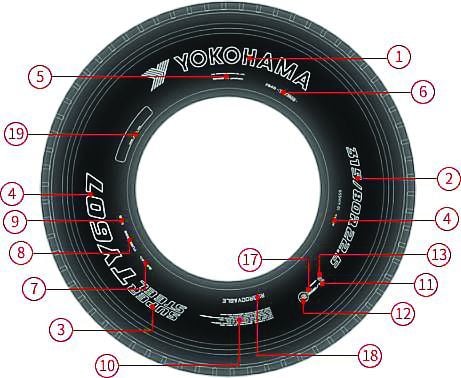
1. Manufacturer’s Name; 2. Tire Size Designation; 3. Brand Name; 4. Tread Pattern Name; 5. Country of Origin; 6. Identification Serial Number; 7. “RADIAL” Designation; 8. “TUBELESS” Designation; 9. Mud and Snow Labelling; 10. Safety Warning; 11. Service Description (LI & SS); 12. Additional Service Description; 13. ECE Mark; 14. Testing Pressure; 15. “REGROOVABLE” Designation; 16. Tire No. Marking Position.
All tires for trucks are marked with:
- Size.
- Maximum load-carrying capacity.
- Maximum inflation pressure.
“The maximum load capacity is only if the tire is inflated to its maximum air pressure. The maximum inflation pressure listed is not necessarily the recommended inflation pressure. Most P-rated tires have a maximum inflation pressure of 44 psi marked on the sidewall; however, this may not be the inflation pressure needed for the vehicle,” Mosier said.
The experts recommend always use the vehicle placard or owner’s manual to find the specified tire size, load range, and tire inflation pressures.
“The placard or owner’s manual provides the vehicle manufacturer-specified tire size and inflation pressures, considering the vehicle’s maximum load-carrying requirements. If tire size changes, the new size must have an equal or greater load-carrying capacity versus the original equipment placard size. If you make vehicle modifications, consult the vehicle manufacturer for guidelines,” Toth added.
What is the Impact of Tire Ply in Load Ratings?
A throwback to days gone by, tire ply rating is no longer a meaningful measurement today. So, why did tire ply used to matter in tires before?
“Before the adoption of load ranges, ply ratings were used to identify the relative strength by indicating the actual number of cotton casing plies. A higher numeric rating or ply count identified tires featuring stronger, heavier duty constructions,” said Todd Bergeson, senior manager, Product Planning & Technical Services for Toyo Tire U.S.A. Corp.
What’s changed with truck tires that makes tire play ratings no longer as useful? Materials used in the construction of modern tires have improved significantly, and therefore, fewer body plies are required to achieve the strength requirements.
“Tire ply ratings are a throwback to the old system when bias ply tires were prevalent, which measured a tire’s carrying capacity by the number of plies in the carcass or body. Today’s radial truck tires have only one steel ply in the carcass, but it is still used as a measure of their carrying capacity. For example, 14-ply tires carry more weight than 12-ply tires,” said Walt Weller, senior vice president of Double Coin Tires.
When bias tires first came about, the strength of the tire casing was built by adding layers of cotton fabric. Ply rating is related to the number of layers of cotton in the tire. Each layer was placed with the thread at an angle to each other. This system added strength due to even tension distribution.
“For example, a Load Range G tire is equivalent to a 14-cotton-ply tire. But, since cotton ply has not been used for many years, having been replaced first by nylon and now with steel cords, these numbers are mostly irrelevant,” said Keller of Continental.
When did the current alphabetical tire load range ratings come about? It’s been more than 50 years now. The alphabetical Load Range rating was created in 1972 as a new standard since the cotton-ply rating has become irrelevant.
“However, the most accurate measurement from an engineering perspective is a Load Index, which relates to the maximum load-carrying capacities allowed at the speed indicated by the speed symbol,” explained David Crawford, head of truck tire development for commercial vehicle tires in North America for Continental.
Today, a tire obtains strength from the sidewall carcass plies when inflated to the proper pressure. The stronger the sidewall carcass plies, the higher the tire load rating.
“For example, ‘LRH’ load rated ‘H’ range can hold up a heavier weight than ‘LRG’ because the steel sidewall plies in an ‘LRH’ are stronger than an ‘LRG,’” said Tatarchuk of Michelin North America, Inc.
But, in some cases, a tire’s Load Range is not an accurate reflection of its Load Index, especially on low-profile tire sizes.
“The TRA allows manufacturers to specify additional load-carrying capacities beyond the Load Range standards, so the tires are labeled as Load Range H, even though they can carry additional weight beyond that load rating,” Crawford said.
For example, the Conti EcoPlus HS3 steer tire in 295/75R22.5 is rated for a maximum weight of 7,160 pounds (single), which would support a vehicle with a 14,000-pound front axle.
“Although it is a Load Range H product, the Conti EcoPlus HS3 is rated for a Load Index 149, above the standard TRA guidelines for a Load Range H product, allowing it to carry the additional weight,” Crawford added.
Load Index values are used in Europe and sometimes in Canada. They are not typically referenced in the United States.
Plies on truck tires enable them to be inflated and keep their round shape.
“A higher ply strength and a larger number of plies will enable tires to operate at higher inflation pressures, which allow them to operate with higher loads. Plies on the sidewall also protect it against curb impact,” said Niknam of Yokohama. “A ply rating is a different way of calling out the load range.”
Ply rating is an older terminology used to represent the tire’s load-carrying capacity. The newer language is Load Range. “For example, when someone references a “14-Ply Rated” tire, they are referring to a Load Range G tire,” explained Mosier of Cooper Tire & Rubber.
Truck tire size is a critical factor in determining the load-carrying capacity.
“A 225/70R19.5 LR G tire has a maximum load capacity of 3,970 pounds at 110 psi when used in a single position. A 245/70R19.5 LR G is a larger tire and has a maximum load capacity of 4,540 pounds at 110 psi when used in a single position. Both are Load Range G tires, but they have different maximum load capacities even with the same inflation pressure due to the tire size,” Mosier said.
In addition, you can tell this is a 19.5-in. commercial truck tire.
What load range are LT tires typically? Most often, LT tires are Load Range C, D, or E. What load range are commercial truck-bus tires? Typically, commercial truck-bus tires are usually Load Range F-L.
The Top Differences in Trailer Tires
A trailer tire is subject to the same TRA standards as all tires for trucks.
“Operators should carefully consider the weight rating of a trailer tire and whether it can safely support the maximum weight that might be placed over their trailer axle,” cautioned Keller of Continental. “In many cases, trailers are not loaded with perfectly even weight distribution over each axle.”
Keller added that, unlike a steer axle where the weight distribution is mostly fixed and coming primarily from the weight of the truck itself, the trailer axle tends to support the variable weight of hauled goods.
“This weight can tend to shift, especially when hauling bulk goods or if the goods are not properly secured.”
The total weight of the cargo cannot be evenly divided by the number of trailer tires, so it is best to assume the weight is the maximum that each tire would carry. Trucks should weigh each axle in a worst-case scenario and should plan for uneven weight distribution, in which one trailer tire carries more weight than another.
Tire load information is vital when trailering.
“As the weight of the vehicle increases, the tire rating should be accounted for to ensure the tires can safely support the load,” said Williams of Hankook Tire.
The TRA also includes a load and inflation pressure table for trailer tires in its annual yearbook.
“Goodyear recommends trailer tires are selected and inflated per the manufacturer placard on the trailer. In cases where the trailer manufacturer placard specifies ST-type tires, LT tires in the same size and load range will not work as they do not have adequate load-carrying capacity,” said Toth of Goodyear.
For example, in cases where the trailer placard specifies an LT (light truck) tire, Toth noted the LT size is acceptable for use.
“Further, because ST (special trailer) tires in like size and load range are designed to carry more load than LT (light truck) tires, an ST tire could be substituted for the LT, but the trailer’s max loading remains unchanged,” Toth said.
When a truck is pulling a trailer, weigh the tractor and trailer.
“Compare the load on each axle needs to the Data Book Load and inflation table. A proper psi corresponding with the load is then used,” noted Tatarchuk of Michelin North America.
All tire manufacturers publish a load vs. pressure inflation table for the tires they manufacture.
“A common mistake many truck operators make is to use the maximum sidewall pressure as the target inflation. The maximum pressure is only needed when the tire is carrying the maximum load. Tires inflated to a pressure higher than necessary will not have the correct contact patch and will not perform in the best possible manner,” Tatarchuk said.
But it’s always best to follow specific OEM recommendations.
“If you replace your tires with an exact OE replacement tire or a suitable replacement tire that meets or exceeds your vehicle’s load requirements according to your vehicle manufacturer’s placard, you will be able to tow up to the maximum trailer rating of your vehicle. We never recommend towing more weight than your truck is rated for, even if you have increased the load-carrying capacity with higher-rated replacement tires,” said Bergeson of Toyo Tire U.S.A. Corp.
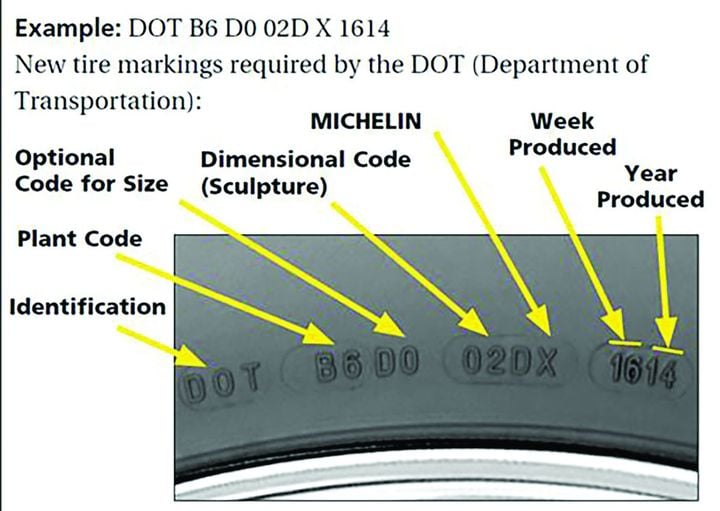
Truck tire markings such as the ones illustrated are required by the U.S. Department of Transportation (DOT).
Just a Few Truck Tire Changes Over the Years
What has changed with truck tires? Well, quite a bit has changed related to tires over the past ten years, including additional load range values, super single tires, and more truck modifications.
“In the past 10 years, some additional Load Range values have been implemented to increase the load-carrying capacity of certain tire sizes. Manufacturers have added a 10,000-pound load capacity (single) to 315/80R22.5 Load Range L tires, increasing from the 9,090-pound load capacity. This is achieved by implementing a speed restriction on the tire,” said Keller of Continental.
Continental and other tire manufacturers have also invested in developing Load Range H variant products, which have an increased load capacity compared to the same tire in a Load Range G variant. Keller noted that these products help fleets carry more payload each trip, reducing the overall number of trips.
Super Single tires have also been added to the market (445/50R22.5 and 455/55R22.5) to assist fleets with fuel savings as well as additional payload to reduce shipments.
Additionally, today’s trucks require the ability to carry more payload.
“The load rating requirements on light trucks continue to increase. Because of this, Toyo Tires offers three of its light truck tires with sizes available in Load Range F. Those are flotation-style products designed for use on late-model pickups, which require 80-psi pressures,” said Bergeson of Toyo Tire U.S.A. Corp.
Modifications on trucks have also become more popular, resulting in a need for changes to tires.
“As a result, the new vehicle weight may require a higher load capacity tire. For that reason, usage of load range F tires is on the rise,” said Niknam of Yokohama Tire.
And technology has come a long way, from compounds to airless solutions and more. The growth of electric vehicles in fleets is also impacting tire manufacturing with the added weight of the vehicles.
Curious about tire news, research, and updates? Make sure to sign up for our eNewsletters today!
Editor’s Note: This article was originally published in 2019 and has been updated as information changes.
Originally posted on Work Truck Online
-
AuthorPosts
- You must be logged in to reply to this topic.